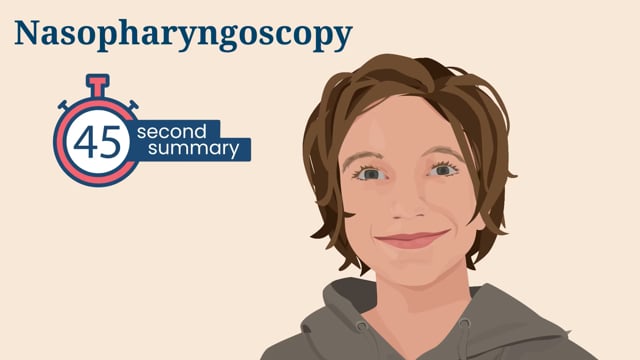What Is Nasopharyngoscopy?
A nasopharyngoscopy (nay-so-fair-en-GOS-kuh-pee) is an exam doctors do to view the back of the throat. They do this by inserting a flexible tube called a scope through the nose. The scope has a light and a camera on the end. These let doctors see how the palate (the roof of the mouth, which separates the mouth from the nasal cavity) moves during speech. The exam takes about 2 minutes.
-

45-Second Summary: Nasopharyngoscopy
Learn the basics in 45 seconds.
Why Is Nasopharyngoscopy Done?
A nasopharyngoscopy helps doctors and speech-language pathologists find the cause of velopharyngeal (vee-low-fair-en-JEE-ul) dysfunction (VPD). VPD happens when the soft palate (PAL-it) does not close tightly against the back of the throat, letting sound and air escape through the nose.
A child with VPD may:
- sound hypernasal (like the child is speaking through the nose)
- have air leaking out of the nose (nasal air emissions) that can be heard
- be hard to understand
Doctors use nasopharyngoscopy to:
- find the location and see the size of the gap that's letting air leak through the nasal cavity
- see how the palate and other parts of the mouth move during speech
- diagnose a submucous cleft palate
- decide on the best treatment plan for managing velopharyngeal dysfunction
What Happens During Nasopharyngoscopy?
Nasopharyngoscopy usually is done in an outpatient clinic. During this quick procedure:
- Your child sits up straight in a chair. A young child might need to sit on a parent's lap.
- The doctor sprays a mixture of topical anesthetic and decongestant into each nostril. This spray opens the nasal passages and can help ease discomfort.
- The doctor (or speech-language pathologist, SLP) inserts a flexible endoscope into the nostril.
- Then, your child is asked to say a variety of words, phrases, and sentences while the doctor or SLP watches what the palate does via a connected TV monitor.
- The scope is removed.
The topical anesthetic might make the throat feel a little numb. So your child should not eat or drink anything for about 30 minutes after the test until the medicine wears off.
What Happens After Nasopharyngoscopy?
The doctor and/or the speech-language pathologist will discuss the test results and treatment options with you. Because nasopharyngoscopy is recorded, health care providers can rewind and review the exam with you to answer any questions.
How Can Parents Help?
A nasopharyngoscopy goes best when a child sits still and follows instructions. If you feel your child might not be able to tolerate the scope, talk to your doctor about another option.
It helps to know that a nasopharyngoscopy is an effective and routine medical test. Complications are extremely rare. But as with most procedures, there are some risks. Your doctor will review these with you. If you have any questions before, during, or after the nasopharyngoscopy, speak with your doctor.


